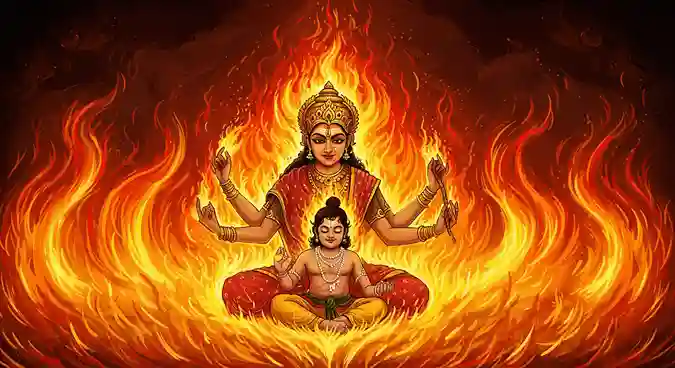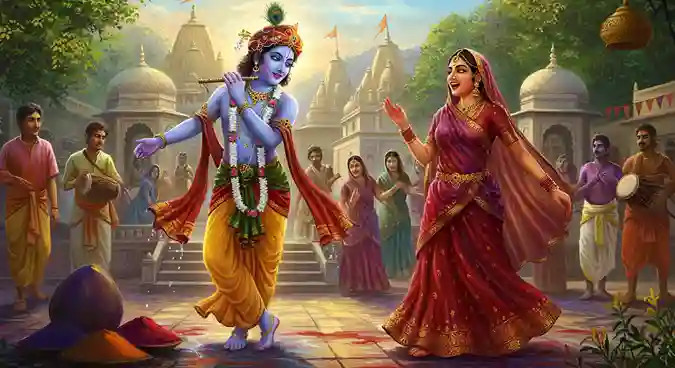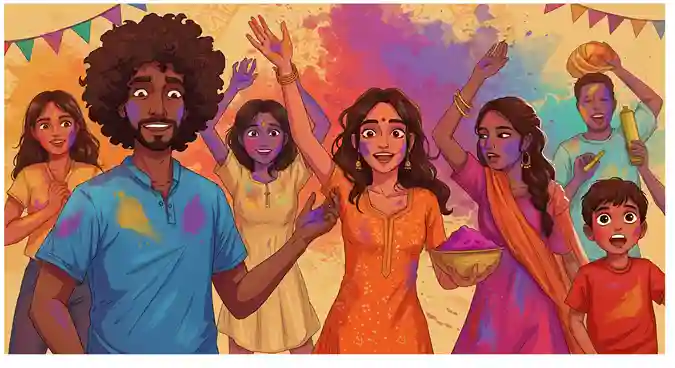Nepal’s Holi: A Festival of Colors, Crowds, and Culture – The Untold Story
By Kushal Shrestha - Apr 16, 2025 | Updated: April 16, 2025 | 12 min read

Holi, popularly known as the “Festival of Colors,” is one of the biggest Hindu festivals in Nepal. It marks the triumph of good over evil. It is a two-day event celebrated on the full moon day of Falgun or Chaitra month (approximately March). Holi in Nepal also signals the end of winter and the beginning of summer.
Holi in Nepal creates a vibrant atmosphere and a colorful environment. During Holi celebrations, people gather in public areas and neighborhoods to throw colored powders and splash water. Before Holi begins, the people light numerous small bonfires to symbolize the elimination of wickedness and create an atmosphere of music, dancing, and joviality.
Holi in Nepal is more than just a celebration; it’s a shared cultural experience. Nepalese people living abroad also celebrate it, keeping the tradition alive worldwide.
Traditional rituals feature shared sweets and special dishes, accompanying musical and dance performances among family members and friends.
It’s a joyful time shared by many communities across the country, from the hills to the plains.
Holi Festival: History and Rituals
As a spectacular festival, Holi maintains its ancient historical significance and connection to mythological events spanning thousands of years. Ancient tales connect Holi’s origin to stories about divine success, romantic love, and cosmic order, thus explaining why we honor colors during this annual celebration.
The Legend of Holika and Prahlada

Among all the stories connected to Holi, people favor the Holi tale of Holika and Prahlada. The mythological history reports that Hiranyakashipu ruled as a demon king and commanded people to worship him as a divine being. Lord Vishnu received Prahlada’s unwavering devotion despite his son living under his father’s rule, Hiranyakashipu.
Hiranyakashipu created different brutal methods to kill Prahlada, but Lord Vishnu shielded the boy from all threats. The king recruited his sister Holika, who had a magical shawl that made her immune to fire. Holika arranged herself next to Prahlada in the blazing fire while imagining his death. The powerful shawl protected Prahlada when it escaped from Holika and encircled him instead of the other way around, and therefore, both the good event and bad result transpired.
Because of this historical event, people maintain Holika Dahan as a ritual to honor the triumph of goodness over wickedness.
The Love Story of Krishna and Radha

According to legend, Lord Krishna and Radha had a playful romantic story during Holi celebrations. The dark blue color makes Krishna uncertain that Radha will embrace him. Yashoda, his mother, proposed to Krishna that he decorate Radha’s face to share their similarity. When Krishna agreed to the idea, Yashoda initiated a new tradition of celebrating by decorating loved ones with colors. Krishna’s passionate romance with Radha is why people commemorate Holi via jovial and playful activities and excitement. Friends and strangers in Nepal maintain a spirit of friendship during Holi when they cheerfully share colors through laughter and dancing.
Rituals of Holi
The celebration of Holi consists of two specific days and includes multiple traditional customs. The traditional rituals start with Holika Dahan on the evening before Holi arrives. People assemble by a blazing fire to sing and dance while saying prayers. The ritual signifies the destruction of evil, as denoted by Holika through the fire, because Prahlad stands for good triumph.
Rangwali Holi is the second day of Holi, during which people exchange colored powder and water. Laughter, dance performances, and music can be heard in parks and streets. People, including friends and strangers, participate regardless of their relations. During the festival, communities prepare traditional foods like gujiya and customarily serve bhang, a drink made with cannabis. People visit daily to exchange gifts and sweets and remove all past hostilities. The celebration of Holi in Nepal concludes with happiness, united communities, and new cycles of life.
Holi’s main event usually happens in the open or in streets and temples, where many people gather to throw colored water balloons. Strangers engage in colorful competitions, putting colors on each other and throwing water simultaneously. People dance to the rhythm of traditional music, distribute sweets, and exchange “Happy Holi!” Greetings warmly with one another. Holi in Nepal is a unifying festival marked by cultural diversity that popularizes the sharing of harmony and the understanding of different societies among its people.
How did Holi start in Nepal?
Cultural Ties with India
India and Nepal have intense religious, linguistic, and cultural relationships. Nepal took a step towards the growth of Hinduism by celebrating major Hindu festivals and cultural events such as Dashain, Tihar, and Holi. The stories and teachings of Lord Prahlad and Holika and the love of Krishna and Radha spread from India to Nepali culture through readings of religious scriptures, temple preaching, and trade activities.
Royal Patronage
The Malla Dynasty, which lasted from the 12th to the 18th century, established Holi in Nepal as a popular tradition that strengthened Nepal’s art, culture, and religion. During the dynasty, Holi became a royal celebration because kings supported Hindu religious events and promoted public celebrations.
All celebrations included various activities such as color play processions and musical performances. People celebrate Holi festivities throughout Kathmandu Durbar Square, which remains the leading celebration site. The location attracts thousands of locals and visitors to join yearly musical events, dancing, and colorful festivities.
Syncretism of Local Practices
Even though the stories and rituals of Holi originate from ancient India, Nepal has adopted unique aspects and celebrations. For instance, Holika Dahan (fire bonfire) has now come to symbolize the people’s power, with people gathering around the fires the night before Holi to pray, sing, and wish each other well communally.
The celebration’s essence is still rooted in the agricultural cycle in the village areas, where the farmers show their gratitude to the gods for the bountiful harvest and ask for blessings for the next sowing season. In the Terai region, which carries the traits of the neighboring Indian states of Bihar and Uttar Pradesh, the festival is observed for more days. Dance performances with an ethnic touch, folk Holi music, and traditional foods such as gujiya and malpua form part of the fest.
READ MORE: Pathao’s Startup Journey to Becoming a Leading Ride-Sharing App in South Asia
Regional Flavors: Hilly vs Terai Holi
Holi in Nepal is celebrated in various ways, depending on the location. Hilly regions such as Kathmandu and Pokhara are vibrant, joyful, and more road-oriented. Holi is celebrated on the full moon day with numerous colors, water balloons, and a lot of dancing. The youth are in charge here, starting with the chir raising, and a festival begins. Very few rituals are performed, and fun is preferred over customs. At Basantapur Durbar Square, a massive crowd comes to enjoy the music while joyful, colored, and splashed by other people. The focus is on enjoyment and not so much on the traditions.
On the contrary, Janakpur and Birgunj celebrate Holi a day later, with a heavy focus and a tendency toward religious and cultural activities in the Terai area. Here, people are engaged in festivals and simultaneously in the story of Prahlad and Holika, where they put up big bonfires on the city streets. The cultural and religious agenda of the celebration is family-based and respectful; thus, the families are playing along and following the tradition that has been served to them throughout generations.
Despite both regions being in concert during the same festival, the mood and the significance can differ vastly. Hilly Holi is rapid, colorful, and intensely exuberant, while Terai Holi is slow, thoughtful, meaningful, and based on traditions. They show themselves as contrasting characters in the Holi celebrations throughout Nepal.
How Holi Might Feel for Me and Others
Holi in Nepal, also known as the “Festival of Colors,” is a cheerful event and may be liked by some and not at all by others, which is perfectly all right.

For Those Who Love the Fun
- A Burst of Joy and Energy: For many people, anything goes on in Holi, including the colorful streets, music, and harmless play. It is a festival of abandoning inhibitions and creating everlasting memories.
- Cultural Connection and Community: Holi in Nepal brings families and neighbors together to create a sense of belonging and pride in culture. Remember, it’s a time to acknowledge traditions and strengthen bonds.
- A path to reconciliation.: Holi also means fixing relations and welcoming brand-new beginnings, boosting personal growth and healing potential.
For Those Who Feel Shy or Overwhelmed
- Sensory Overload: Holi’s festive atmosphere, full of loud music and crowded streets, can overwhelm certain people. Feelings of shyness or discomfort are entirely normal.
- Personal Comfort and Boundaries: Your boundaries are essential, so take your time participating in the festival. You can still participate meaningfully; there are quieter ways to do so, even from a distance.
- Finding Your Joy: Participating in those enormous grand celebrations isn’t mandatory for everyone. Sometimes, you can enjoy Holi through quieter rituals, festive foods, or simply appreciating the colors.
Acknowledging Different Feelings
- Respect and Understanding: Various people experience feelings differently, considering the Holi festival. Therefore, both excitement and shyness are natural and should be respected equally. Holi should be played only on the festival day and not before that. Throwing water balloons at students, people going to work, or the elderly is disrespectful and does not promote Holi’s culture.
- Creating an Inclusive Environment: You should check everyone’s comfort and allow them to participate as they want so that you all can have an enjoyable and united Holi experience. Be respectful and ask for consent.
- Embracing Diversity: As a festival, Holi is dedicated to the fact that people are all different. If we understand people’s various moods, we create a more cheerful celebration.
Simply put, Holi in Nepal means finding happiness and being part of something in one’s way. If you either partake in the festivities or watch the celebrations from a distance, the occasion is equally enjoyable because it is open to everyone.
If you are fond of Nepalese food and culture or how Nepal is delivering food to the people at home, visit the Foodmandu Enterprise Story: Pioneering Nepal’s Food Delivery Revolution
What Can I Do During Holi in Nepal?
Holi is a fun-filled and colorful festival in Nepal! Here are a few things you may try if you wish to enjoy this festival fully, whether you love getting into the middle of the action or prefer to take it easy.
If You Want to Join the Fun
- Play with colors: You can use dry powders for colors or non-toxic watercolors. Avoid throwing water balloons made of hard material, or dirty water. Avoid throwing balloons at strangers who are simply doing errands. Holi celebrations should be mutual, not forceful.
- It is recommended that old clothes are worn so they don’t get stained, which is most likely to happen. Therefore, you shouldn’t wear anything new or fancy.
- Before the paint and the colors dry, rub oil or lotion on your hair and skin. This will make it easier to remove all the paint later.
- Traveling with friends or family: Traveling in pairs or groups is much safer and more enjoyable.
- If you have a situation, do not hesitate to speak to an adult or a trusted person about it. If you are uncomfortable with someone or feel that the situation is unsafe, don’t hesitate to talk to someone you like and trust.
If You Want to Celebrate Quietly
- Enjoy from a distance: You can watch people celebrate without getting involved.
- You can also contribute food or decorations. In addition to colors, sweets, and lights, you can assist with music if available.
- Create art or crafts at home: Using Holi colors and crafting colorful decorations can be fun.
- Celebrate only with your close family. There are no big crowds; it is only fun with known people.
If You Don’t Want to Join
- It is okay to say ” no “ even if you do not want to be colored.
- Stay inside during peak hours; you can still have fun on your way during the holiday.
- Carry out a task you like best: read, sketch, or play a video game; it is your day.
Whether you go out, stay at home, celebrate quietly with friends, or have a big party, the Holi festival is also personal to you. You can participate, be an observer, assist, or take time for yourself.
Holi in Nepal is a chaotic festival and a festival of color. But honestly, it is a festival of connections. The buzz creates a special energy, laughter, and colors flying around. Holi in Nepal signifies a great coming together of people. Whether colored or not, people can practically join in the fun. It is so infectious in its joy that it makes it all the more worthwhile.
Most important of all is making Holi in Nepal a personal celebration. Whether throwing colors in the streets with thousands of people or with a small family gathering, the spirit that goes along with it matters; you should not have to follow anyone else’s rules; celebrate it your way. Get into it if you love crazy excitement. Or take it smooth if you prefer that. The essential thing is to try some activity that connects you to the people in your life and the local culture that makes Nepal unique.
Celebrate it as you feel because it is Holi, which is breaking free from the regulars, connecting with other people, and cherishing the essence of life, even with a few colors on your skin!
Notice an error?
Help us improve by submitting a correction.







